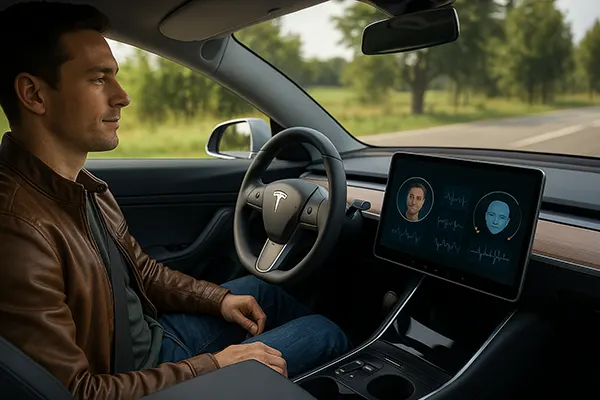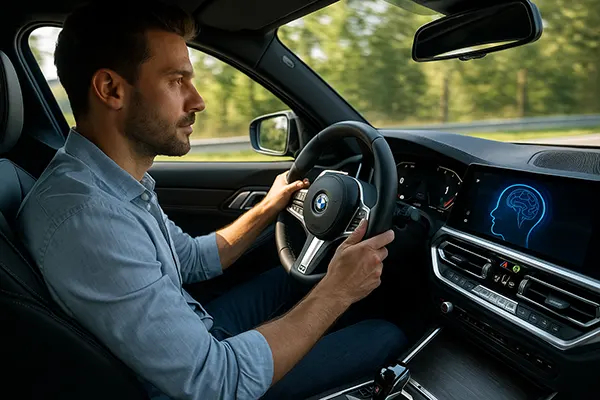Biometric Systems in Cars: How Tesla and BMW Detect Drivers’ Emotions

In the modern automotive world, manufacturers are constantly seeking ways to enhance road safety, comfort, and personalisation. One of the most promising directions in this journey is biometric systems — technologies that allow vehicles to “read” and interpret the emotional and physical condition of the driver. As of February 2025, companies like Tesla and BMW are pioneering this integration of artificial intelligence with human physiology to fundamentally redefine the driving experience.
Biometrics Behind the Wheel: From Science Fiction to Reality
Modern biometric systems are no longer confined to smartphones or airport security. Tesla and BMW are among the leaders bringing this technology into their vehicles. They equip cars with cameras, sensors, and algorithms capable of analysing micro-expressions, eye movement, heart rate, and even skin conductivity. These elements combine into a robust system that helps assess the driver’s current state — whether they’re tired, stressed, distracted, or calm.
For instance, Tesla utilises an internal camera that monitors the driver’s eyes and face. If signs of drowsiness or distraction are detected, the system may issue a warning or reduce the vehicle’s speed. BMW’s approach is more immersive. The BMW iX uses its iDrive system integrated with biometric sensors to evaluate driver behaviour and emotion, suggesting changes in lighting, music, or air temperature to improve mood and focus.
This shift from reactive safety features (like airbags and ABS) to proactive systems means biometric monitoring can help prevent accidents before they occur, based on early signs of impaired driving ability.
Technology Enabling Emotional Analysis
The core of these systems lies in artificial intelligence and computer vision. Using machine learning, the software is trained on vast datasets of facial expressions and biometric feedback linked to various emotional states. Over time, the system becomes more accurate in recognising subtle indicators of fatigue, anxiety, or agitation.
Infrared cameras and sensors embedded in the dashboard, seat, or steering wheel collect data continuously. For example, a sudden change in pupil dilation or heart rate might indicate stress. The car responds in real time — adjusting seat massage intensity, dimming ambient lighting, or prompting a break suggestion through the navigation system.
By building an emotional profile of the driver, these vehicles can not only intervene during risky conditions but also learn preferences, thereby tailoring the overall experience. In high-end BMW models, this feature is called “My Modes” — offering emotional and cognitive support during travel.
Practical Applications and Real-World Benefits
Beyond the impressive tech specifications, biometric systems have very real implications for road safety and driver wellness. According to the European Commission for Mobility and Transport, over 20% of road fatalities involve fatigue-related factors. Addressing this through biometric detection is a proactive step towards reduction.
These systems can also enhance driving comfort. If the car detects heightened stress, it might suggest a less congested route, play calming music, or reduce cockpit notifications. In shared vehicle scenarios, emotional recognition may even adjust settings according to the current driver’s preferences and mood profile.
Furthermore, biometric systems support inclusivity. Drivers with medical conditions — such as epilepsy or heart irregularities — could benefit from early alerts about symptoms before a health crisis develops. In such cases, the system may suggest pulling over or even trigger emergency services automatically if severe anomalies are registered.
Limitations and Ethical Concerns
Despite the potential, biometric systems are not without challenges. Accuracy in emotional recognition remains an ongoing concern, especially given cultural differences in expression and physiology. False positives could cause distractions or annoyance.
There are also significant privacy issues. Continuous monitoring of one’s emotional and physiological data raises questions about data storage, consent, and access. Both Tesla and BMW claim that biometric data is stored locally in the vehicle, but clarity and regulation are essential to avoid misuse or breaches.
Lastly, overreliance on automation could lead to driver complacency. As cars become more autonomous and intuitive, maintaining driver engagement remains critical — especially when full autonomy is not yet legally or technically feasible.

What the Future Holds for Emotionally Intelligent Cars
By 2025, biometric systems in vehicles are not a luxury but an emerging standard, especially in the premium and electric segments. Tesla and BMW continue to lead development, with more manufacturers expected to follow as costs decrease and technology matures.
In the near future, we may see expanded capabilities — such as biometric personalisation for each passenger, or integration with wearable tech for even more precise monitoring. The goal is clear: to create a safer, more human-centred driving environment.
Public acceptance will play a major role. Clear regulation, transparency in how biometric data is handled, and opt-in models are key to building trust. As these systems evolve, they must balance safety and ethics — providing not only protection but respect for driver autonomy and dignity.
Conclusion: From Monitoring to Partnership
The adoption of biometric technology in vehicles signals a shift from passive tools to interactive co-pilots. By recognising human emotion, cars become companions — responsive, attentive, and supportive.
In the hands of forward-thinking manufacturers like Tesla and BMW, these innovations are more than trends. They represent a new chapter in driving — where emotional awareness is just as crucial as mechanical reliability.
As this technology matures, drivers can expect not only safer roads, but a more personalised and attentive relationship with their vehicles. And that is no longer science fiction — it’s today’s reality.




